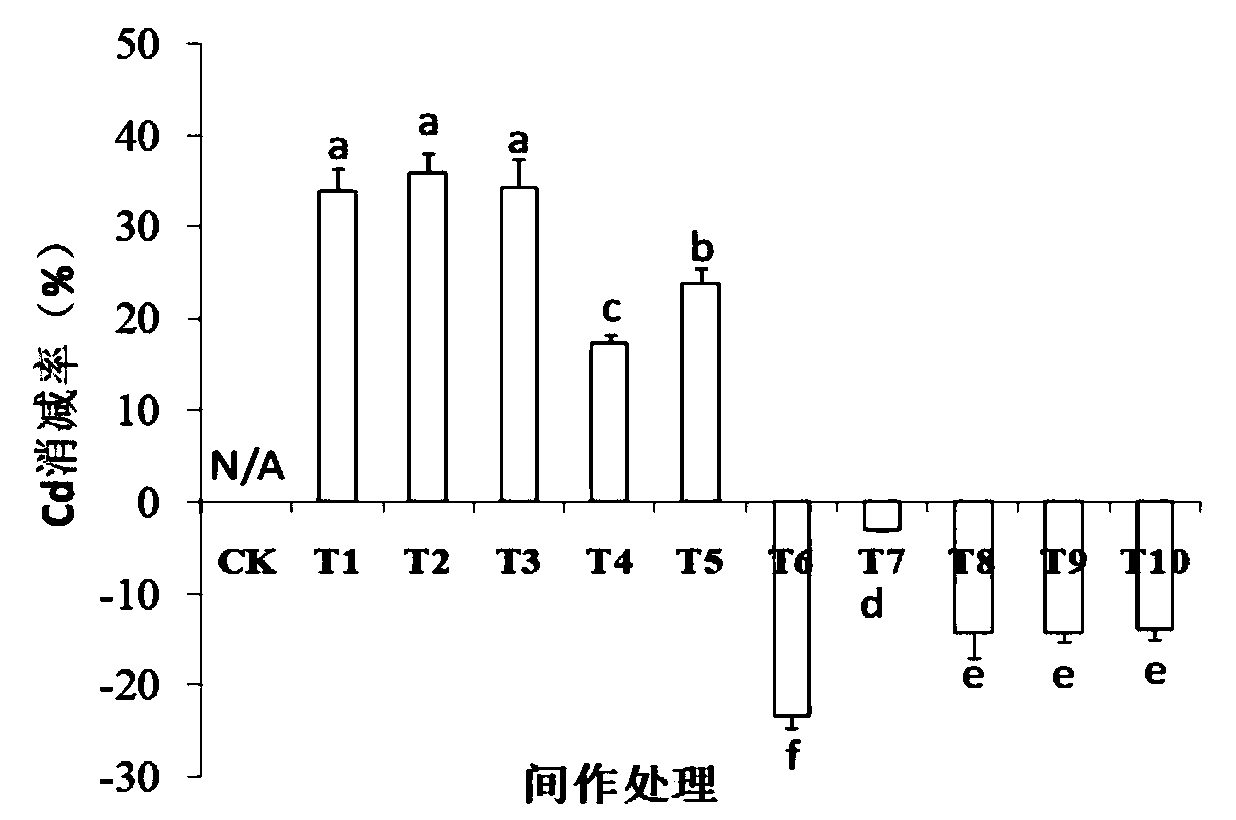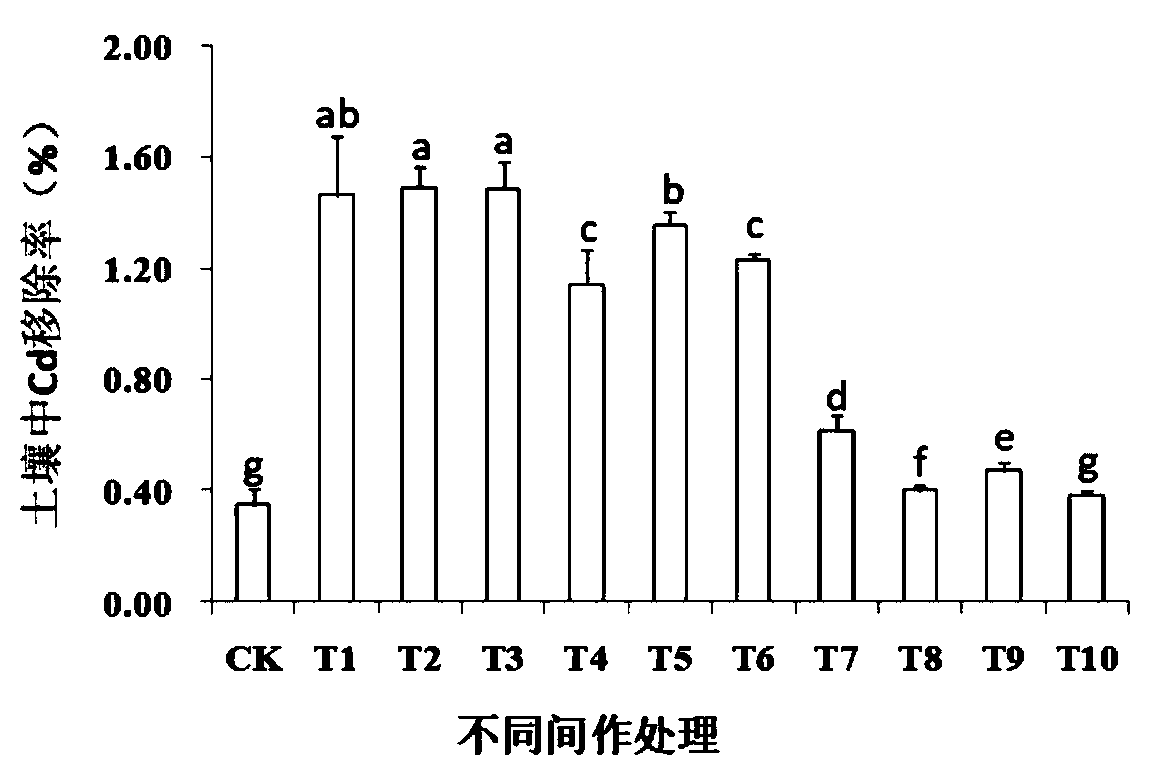Method for repairing Cd contaminated soil by intercropping herbs and swamp cabbage
A herbaceous plant and polluted soil technology, applied in the field of contaminated soil remediation, can solve the problems of unclear absorption and transport mechanism of heavy metals, affecting the efficiency of heavy metal polluted soil, slow growth, etc., and achieve obvious ecological benefits, fast growth, and high biomass high effect
- Summary
- Abstract
- Description
- Claims
- Application Information
AI Technical Summary
Problems solved by technology
Method used
Image
Examples
Embodiment 1
[0020] Embodiment 1, crop and intercropping plant and vernalization
[0021] The main crop is Ipomoea aquatic forsk.
[0022] Intercropping herbs include: Sorghum bicolor L., Sudan grass (Sorghum sudanenseStapf), Pennisetum americanum x P, Ryegrass (Lolium perenne L.), Sonchus arvensis L. , chicory (Cichorium intybus L.), grain amaranth (Amaranthus hypochondriacus L.), clover (Trifolium repens L.), alfalfa (Medicago sativa L.), milk vetch (Astragalus sinicus L.).
[0023] The seeds were purchased from Beijing Hejia Ecological Technology Co., Ltd. and Jiangsu Yujingyuan Greening Engineering Co., Ltd., after 10% H 2 o 2 After the solution was disinfected for 10 minutes, it was washed several times with water, and the seeds were soaked in deionized water for 8 hours, then transferred to a petri dish to promote germination, and then sowed uniformly.
Embodiment 2
[0024] Embodiment 2, different herbaceous plants and water spinach intercropping test process
[0025] The experiment included 11 treatments: water spinach intercropping (CK), water spinach intercropping with sunflower grass (T1), water spinach intercropping with sudan grass (T2), water spinach intercropping with Pennisetum (T3), water spinach intercropping with ryegrass (T4 ), Intercropping of water spinach and bitter gourd (T5), intercropping of water spinach and chicory (T6), intercropping of water spinach and grain amaranth (T7), intercropping of water spinach and clover (T8), intercropping of water spinach and alfalfa (T9), intercropping of water spinach and Ziyun British intercropping (T10), 4 repetitions for each treatment. The pot experiment was carried out in a solar greenhouse. The test used a PVC long tank with a length, width and height of 60, 40 and 30 cm, respectively. Each pot was filled with about 36 kg of air-dried soil through a 2 mm sieve. .
[0026] As a c...
Embodiment 3
[0028] Embodiment 3, determination index and method
[0029] When harvesting, plant samples of water spinach and the aboveground parts (stems and leaves about 1 cm away from the soil surface) and roots of water spinach and each intercropping plant were taken, rinsed with tap water and deionized water, dried naturally at 105 ° C for 30 min, and then 70 Dry at ℃ to constant weight, and measure the dry weight of the aboveground part of the sample. The dried plant sample is pulverized with a pulverizer, mixed evenly, and passed through a 0.25mm sieve for later use. The Cd content of the soil sample is digested with HNO3-HClO4-HF, and the Cd content of the plant sample content using HNO 3 -HClO 4 Digestion, using ICP-MS to determine the content of cadmium in soil and plant digestion solution.
[0030] Cd reduction rate of crops (DRCd,%): Compared with the control (CK), the percentage of Cd reduction in the stems and leaves of water spinach in different intercropping treatments (%...
PUM
 Login to View More
Login to View More Abstract
Description
Claims
Application Information
 Login to View More
Login to View More - R&D
- Intellectual Property
- Life Sciences
- Materials
- Tech Scout
- Unparalleled Data Quality
- Higher Quality Content
- 60% Fewer Hallucinations
Browse by: Latest US Patents, China's latest patents, Technical Efficacy Thesaurus, Application Domain, Technology Topic, Popular Technical Reports.
© 2025 PatSnap. All rights reserved.Legal|Privacy policy|Modern Slavery Act Transparency Statement|Sitemap|About US| Contact US: help@patsnap.com



